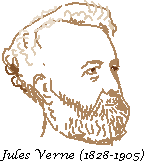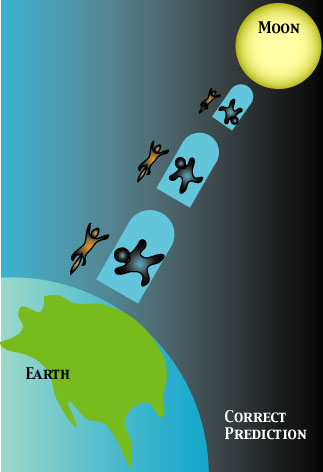

Eddington, and Taylor & Wheeler on Jules Verne's Trip around the Moon
¬@
 |
|
Eddington may be the first to criticize Jules Verne's description of a space trip around the moon (A Trip around the Moon, 1870; this is the sequel of From the Earth to the Moon, 1865).
Jules Verne's book Round the Moon tells the strory of three men in a projectile shot from a cannon into space. The author enlarges on their amusing experiences when their weight vanished altogether at the neutral point, where the attraction of the earth and moon balance one another. As a matter of fact, they would not have had any feeling of weight at any time during their journey after they left the earth's atmosphere. (Eddington, 1920, 65)
Long later (1963), Taylor and Wheeler (Spacetime Physics, 1st ed., 1963, 2nd ed., 1992) were to elaborate the same point in more detail. Verne's strory goes like this: Eminent American cannon designers made a big cannon; and from this cannon, a ten-ton projectile was fired towards the Moon; in it are three men and several animals, including the dog Satellite. This dog unfortunately dies from injuries, and its body is disposed through a door of the projectile; but passengers find the body floating outside the window during the entire trip. On the other hand, Verne incorrectly predicts that the passengers will find their weights vanishing at a certain point in between the earth and the Moon, as was already told by Eddington. The following figures are an adaptation of the Figure 2-2 of Taylor & Wheeler.
 ¬@
¬@ 
Verne's description is inconsistent, in that Satellite and the spaceship share the same motion (free float), whereas the passengers in the ship have different motions, depending on the location of the ship. Of course, they should also share the same motion of free float, which means that they do not feel any attractive force, neither from the earth nor from the moon! Notice that the spaceship does not have any means of acceleration (rocket engine, say), once it is out of the atmosphere.
If you are still unconvinced, recall Newton's figure:
This is the figure in "The System of the World" (Motte & Cajori translation, p. 551), which illustrates the action of gravitational forces. Each curve shows a free float particle, with a different initial velocity, and if a man is on that particle, he will not feel any force of gravity. And, of course you can add another curve, the trajectory of Verne's projectile (spaceship) towards the moon, which is another free float object.
The point is, the spaceship, the passengers in it, and the poor Satellite are all subject to the same gravitational field, and hence relative to each other, no gravitational effect exists.
See also Free Fall.
Reference
¬wį┌Ųó╔E„ß┘s¬x¬iW. J. ░~░┼¬[Ō┘¬A┘Ł┌R┘G÷Ś¬jŁ└ŁąŁå”įā¬A1999¬iŁ▒ŁÉŁĻ Verne 1865 ŁĒ┼p÷ŚŁ®ŁŹŁĒ÷M÷Ś¬j¬B
Last modified, July 16, 2002. (c) Soshichi Uchii
suchii@bun.kyoto-u.ac.jp